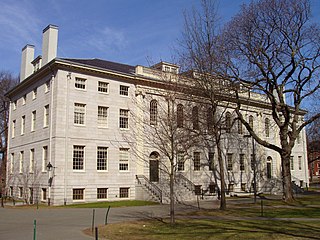
University Hall is a white granite building designed by the great early American architect Charles Bulfinch and built by the noted early engineer Loammi Baldwin, Jr. It is located in Harvard Yard on the campus of Harvard University in Cambridge, Massachusetts. It was designated a National Historic Landmark in 1970 for its architectural significance.

Sycamore Shoals State Historic Area is a state park located in Elizabethton, in the U.S. state of Tennessee. The park consists of 70 acres (28.3 ha) situated along the Sycamore Shoals of the Watauga River, a National Historic Landmark where a series of events critical to the establishment of the states of Tennessee and Kentucky, and the settlement of the Trans-Appalachian frontier in general, took place. Along with the historic shoals, the park includes a visitor center and museum, the reconstructed Fort Watauga, the Carter Mansion and Sabine Hill . For over a thousand years before the arrival of European explorers, Sycamore Shoals and adjacent lands had been inhabited by Native Americans. The first permanent European settlers arrived in 1770, and established the Watauga Association—one of the first written constitutional governments west of the Appalachian Mountains—in 1772. Richard Henderson and Daniel Boone negotiated the Treaty of Sycamore Shoals in 1775, which saw the sale of millions of acres of Cherokee lands in Kentucky and Tennessee and led to the building of the Wilderness Road. During the American Revolution, Sycamore Shoals was both the site of Fort Watauga, where part of a Cherokee invasion was thwarted in 1776, and the mustering ground for the Overmountain Men in 1780.

The Dr. Generous Henderson House is a historic home located at 1016 The Paseo, once one of the most prestigious areas of Kansas City, Missouri.

Cobblestone Farmhouse at 1229 Birdsey Road is a farmhouse in the town of Junius, New York, in Seneca County, New York. It is significant as a well-preserved example of cobblestone architecture, in a vernacular Greek Revival style. North of the house, there is also a large barn believed to date to the late 19th century. This property was listed on the National Register of Historic Places on August 6, 2008. It is the sixth property listed as a featured property of the week in a program of the National Park Service that began in July, 2008.
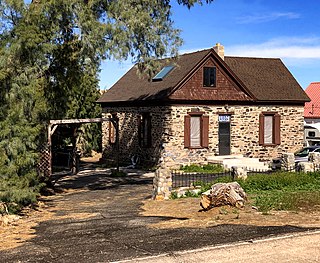
Parley Hunt House is a historic home in Bunkerville, Nevada which was listed on the National Register of Historic Places in 1991.

Hancock's Resolution is a historic two-storey gambrel-roofed stone farm house with shed-roofed dormers and interior end chimneys located on a 15-acre farm at 2795 Bayside Beach Road in Pasadena, Anne Arundel County, Maryland, United States. In 1785 Stephen Hancock, Jr. built the original stone section as the main house for what was then a 410-acre farm. Additions to the house were built in 1855 and in about 1900. Stone and frame outbuildings remain, including a one-storey gable-roofed stone dairy. Hancock's Resolution remained in Hancock family ownership until the deaths in the 1960s of Mary Hancock and her brother, Henry Hancock, who left the property to Anne Arundel County to be preserved. Hancock's Resolution underwent a thorough restoration in 2000 and is now open to the public as a house museum.
Henderson House, and variations, may refer to:

The Almeron Durkee House is a historic house located at 13 Cayuga Street in Union Springs, Cayuga County, New York.

"Melrose", also known as the Old President's House, is a historic home located on the campus of Cheyney University of Pennsylvania in Cheyney, Delaware County, Pennsylvania. It is a 2 1⁄2-story, vernacular stone residence. It has three sections: the original section built before 1785, a three-bay addition built in 1807, and a two-bay addition built about 1850. The 122-acre farm for which the house served as the main residence became the basis for the Cheyney University of Pennsylvania campus. The house served as the President's House from 1903 to 1968.

The Episcopal Church of the Saviour, also known as Memorial Episcopal Church, is a parish church in the Episcopal Diocese of Iowa. The church is located in Clermont, Iowa, United States. The church building, along with the statue of David Henderson, was listed on the National Register of Historic Places in 2000.
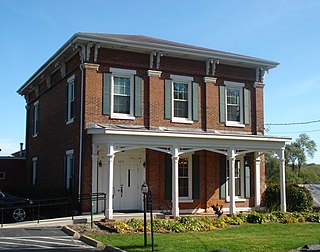
The Dawley House is an historic property located in Le Claire, Iowa, United States, and has been listed on the National Register of Historic Places since 1979. It is the former home of Daniel V. Dawley. The property is part of the Houses of Mississippi River Men Thematic Resource, which covers the homes of men from Le Claire who worked on the Mississippi River as riverboat captains, pilots, builders and owners.

Henderson Hall Historic District, is a historic home and national historic district located near Williamstown, Wood County, West Virginia. It encompasses 10 contributing buildings, 4 contributing structures, 1 contributing site, and 1 contributing object. The primary building is "Henderson Hall," a three-story, Italianate mansion built between 1856 and 1859. Attached to the dwelling is a rear block, constructed in 1836. The remaining buildings are part of the associated farm complex. They include a log smokehouse, carriage barn and schoolroom, log corn crib, corncrib, scale house, cow barn, barn, tenant house, "Woodhaven", Henderson Cemetery, stone terrace wall, stone mounting block, and three prehistoric Indian mounds.

Dr. William Henderson House, also known as the Fox House, is a historic home located at Hummelstown, Dauphin County, Pennsylvania. It was built in 1854, and is a three-story, brick style townhouse on a stone foundation. It has brownstone window sills and stoop. There is a three-story rear extension and, on that, a one-story frame addition dated to 1918.
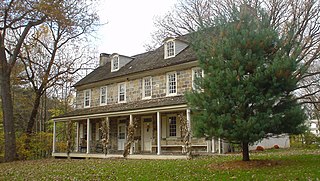
Collen Brook Farm, also known as Collenbrook, is a historic home and associated buildings located at Upper Darby Township, Delaware County, Pennsylvania. The complex includes three contributing buildings: a farmhouse, a granite spring house, and stone and frame carriage house. The house is a 2 1⁄2-story, vernacular stone residence with a Georgian plan and consisting of three sections. The oldest section was built around 1700, with additions made in 1774, and 1794. It was the home of noted educator and political leader George Smith (1804–1882).

John and Nancy Yeatts House is a historic home located near Chatham, Pittsylvania County, Virginia. The log double pen house was built in two sections with the original section built about 1808, and expanded probably in the 1820s but before 1860. The original section has v-notched logs, a stone gable end chimney, and front and back entries. The later section is of similar construction and also has a stone gable end chimney. The two sections are topped by a standing seam metal gable roof. It is representative of a finely crafted and well-preserved vernacular log dwelling.
Daniel Stone Plank House was a historic home located near Henderson, Vance County, North Carolina. It dated to the late-18th or early-19th century, and was a two-story, sawn plank farm house. It was built and altered in at least three periods, and measured 22 feet long by 23 feet deep. It was moved to its listing site about 1885, and featured a gable roof projecting over the vertical plane of the walls on all four elevations. It has been demolished.

The Bell Covered Bridge is a historic wooden covered bridge in rural Washington County, Ohio, United States. One of several such bridges in the region built by the same man, it has remained open to traffic with the exception of periodic repairs, and it has been named a historic site.

Bals–Wocher House is a historic home located in Indianapolis, Indiana. It was built in 1869–1870, and is a three-story, Italianate style brick dwelling with heavy limestone trim. It has a low hipped roof with deck and paired brackets on the overhanging eaves. It features stone quoins and an off-center arcaded loggia.

The Hunt Hill Farm is a historic farm property at Upland and Crossman Roads in New Milford, Connecticut. Also known as the Hine–Buckingham Farms, the 137-acre (55 ha) property encompasses two farm properties that remained family-run from the 18th to early 20th centuries. The property includes one 18th and several 19th-century farmhouses and other outbuildings. It was listed on the National Register of Historic Places in 2004. The farmstead is now home to The Silo at Hunt Hill Farm, an arts and culinary organization, while much of the land is held as conservation land by the town.
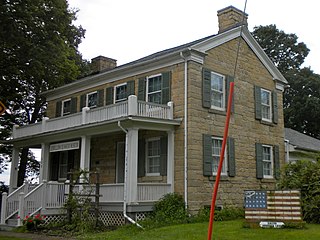
The Henderson Lewelling House, also known as the Lewelling Quaker Museum, is a historic building located in Salem, Iowa, United States. Henderson Luelling and his wife Elizabeth were among the first settlers in the Quaker community of Salem in 1837. They moved here from Henry County, Indiana, and Henderson moved his fruit tree nursery with him. This was Iowa's first commercial nursery. Henderson built this two-story stone house with Greek Revival details in 1843. The Lewellings were abolitionists associated with the Society of Anti-Slavery Friends, and his home is thought to have been a stop on the Underground Railroad. The family left Salem for Oregon in 1847, taking the nursery with them.




















